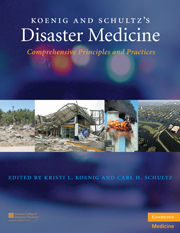Book contents
- Frontmatter
- Contents
- List of Contributors
- Contributor Biographies
- Foreword
- Preface
- Acknowledgments
- PART I CONCEPTUAL FRAMEWORK AND STRATEGIC OVERVIEW
- PART II OPERATIONAL ISSUES
- PART III CLINICAL MANAGEMENT
- SECTION A CBRNE AND HAZMAT
- SECTION B ENVIRONMENTAL EVENTS
- 32 Floods
- 33 Cyclones/Hurricanes/Typhoons
- 34 Tornadoes
- 35 Earthquakes
- 36 Tsunamis
- 37 Winter Storms
- 38 Extreme Heat Events
- 39 Volcanoes
- Index
- Plate section
- References
36 - Tsunamis
from SECTION B - ENVIRONMENTAL EVENTS
Published online by Cambridge University Press: 05 August 2011
- Frontmatter
- Contents
- List of Contributors
- Contributor Biographies
- Foreword
- Preface
- Acknowledgments
- PART I CONCEPTUAL FRAMEWORK AND STRATEGIC OVERVIEW
- PART II OPERATIONAL ISSUES
- PART III CLINICAL MANAGEMENT
- SECTION A CBRNE AND HAZMAT
- SECTION B ENVIRONMENTAL EVENTS
- 32 Floods
- 33 Cyclones/Hurricanes/Typhoons
- 34 Tornadoes
- 35 Earthquakes
- 36 Tsunamis
- 37 Winter Storms
- 38 Extreme Heat Events
- 39 Volcanoes
- Index
- Plate section
- References
Summary
OVERVIEW
A tsunami is a series of waves created when a massive volume of ocean water is rapidly displaced. Tsunami waves are created as the mass of displaced water radiates relative to gravitational forces across an ocean or sea. Commonly, submarine earthquakes are associated with tsunamis, but other geophysical events causing mass displacement of water will generate tsunami waves. These may consist of underwater landslides, volcanic eruptions, meteorite impacts, and submarine explosions, including nuclear detonations. Tsunami events are best classified as sudden-impact disasters.
The term tsunami is of Japanese origin from the words “tsu” meaning harbor and “nami” meaning wave. Tsunamis usually occur in a series of nonrhythmic waves as opposed to a single wave. The first tsunami wave to approach a shore is often not the largest in the series. In open ocean, tsunami waves can have a wavelength of up to 700 km (435 miles) and propagate at speeds of 640 km (400 miles) per hour. In open water, tsunamis may have a wave height (amplitude) of only a few centimeters. Upon reaching shallow water, however, the waves slow and build to heights with inertial energy well beyond those of wind-generated waves (Figure 36.1).
Tsunamis can cause severe damage to coastal areas as they “run-up” onshore and dissipate wave energy caused by the massive displacement of ocean water. The destructive effect of a tsunami is controlled by the submarine topography in front of the land area that the tsunami approaches.
Keywords
- Type
- Chapter
- Information
- Koenig and Schultz's Disaster MedicineComprehensive Principles and Practices, pp. 578 - 585Publisher: Cambridge University PressPrint publication year: 2009
References
- 1
- Cited by



